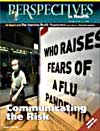
The Man Who Made Polio History(Final)A Pan American successAfter Jonas Salk and Albert Sabin, few individuals deserve more credit for polio eradication in the Americas than Ciro de Quadros, the Brazilian epidemiologist who headed the Pan American Health Organization's immunization program from 1977 to 2002. After playing a key role in the global campaign to eradicate smallpox, de Quadros took on the polio challenge in the face of what many others saw as insurmountable obstacles. Fresh out of medical school in the late 1960s, de Quadros accepted a position as chief medical officer at a health center in a small town in the Amazon region of his native Brazil. Armed with Sabin's oral polio vaccine as well as the DPT (diphtheria, pertussis, and tetanus) vaccine, BCG to fight tuberculosis, and tetanus booster shots, he set out with his tiny staff to bring immunization levels up to 100 percent in the area served by his health center. It was an ambitious goal; at the time, immunization rates in many parts of Brazil were less than 10 percent. A meticulous record keeper, de Quadros kept track of all the families in his assigned area. He would send out a staff member to locate any child who missed a scheduled immunization appointment. In time, the efforts paid off; by 1989, polio had been wiped out in Brazil. By 1981, de Quadros had set himself the goal of eradicating polio from throughout the Americas. While respected colleagues insisted it couldn't be done, he disagreed, pointing to promising data from two weekends of National Immunization Days, or NIDs, held in Brazil starting in 1980. "On each of those weekends, about 20 million children under 5 years of age received a dose of oral polio vaccine regardless of previous vaccination status," de Quadros wrote in the 1997 book Polio. "Cases of polio dropped dramatically from an average of over 100-200 cases per month to fewer than 20." Mustering support was not easy. WHO's director general, Halfdan Mahler, at first strenuously opposed de Quadros' global eradication plan, decrying it as a vertical program that detracted from efforts to expand primary health care. Many others were simply skeptical. "Political and social will was often a problem," de Quadros recalls today. Moreover, "disease surveillance was virtually nonexistent in many of the region's countries." At first, the project lacked financial resources, and several of the target areas were struggling with civil unrest. It was Albert Sabin himself who came to the rescue. "Rotary International was planning its centennial in 2005 and was looking for a global target that could be achieved by that date," says de Quadros. "Sabin approached them with the idea that it could be the global eradication of polio." 
With that, Rotary International committed to raise $120 million in five years to purchase vaccines for the eradication effort. De Quadros' plan was finally rolling. The goal of eradicating polio from the Americas was announced by then PAHO Director Carlyle Guerra de Macedo at a May 14, 1985, press conference in Washington, D.C., with Sabin and Salk both present. UNICEF, the Inter-American Development Bank, and the U.S. Agency for International Development also committed millions of dollars. Citing the success of NIDs in Cuba and Brazil, de Quadros and his supporters agreed that NIDs were the best way to reach the most people. They also suggested that the countries offer other routine health care services at the same time to increase participation. In some countries, civil unrest threatened to undermine the efforts. Immunization workers feared for their lives in El Salvador and in Peru. De Quadros called on UNICEF, the Red Cross, and even the Catholic Church to intervene. He also took the bold step of appealing directly to the warring parties. The result in El Salvador was an agreement to hold "days of tranquility" so that NIDs could go on as scheduled. "We organized three days of tranquility each year, and we vaccinated nearly every child in El Salvador," says de Quadros. "We had to negotiate with both government and guerrilla forces, and that was only possible because the goal of vaccinating children was such a noble cause." In Peru, negotiating with the ruthless Shining Path guerrilla movement proved unsuccessful. Undeterred, de Quadros and his cadres organized a series of mop-up campaigns to help limit poliovirus transmission to just a few areas. They also engaged the media, using press conferences to appeal to everyone—including the guerrillas—to cooperate with the vaccination efforts. A few months later, when key guerrilla leaders were captured by government forces, de Quadros' team recognized several as having directly assisted the mop-up campaign. By 1991, Peru had reported the last confirmed case of wild polio, and in 1994, an international commission officially declared the disease eradicated from the Americas region. In 1988, the World Health Assembly announced the goal of global polio eradication by the year 2000. The target date was later changed to 2008, and despite a number of recent setbacks, global polio eradication is considered achievable within the next few years. Lessons learned from polio eradication in the Americas have been applied to other public health efforts around the world. For example, Mahler's model of piggybacking primary health care onto specific immunization efforts is still being emulated. In Africa, where HIV, measles, and meningitis are more of a daily threat than polio, workers have offered meningitis and measles shots along with the polio vaccine to help attract more people. The notion of "health as a bridge for peace" has been used in countries including Lebanon and Afghanistan. Says de Quadros: "If we apply the lessons learned from this experience to other public health initiatives we will have a healthier world as a legacy to our children."
|
Articles: The Man Who Made Polio History Mothers and Children: Make Them Count Columns: Last Word For Printing: |
